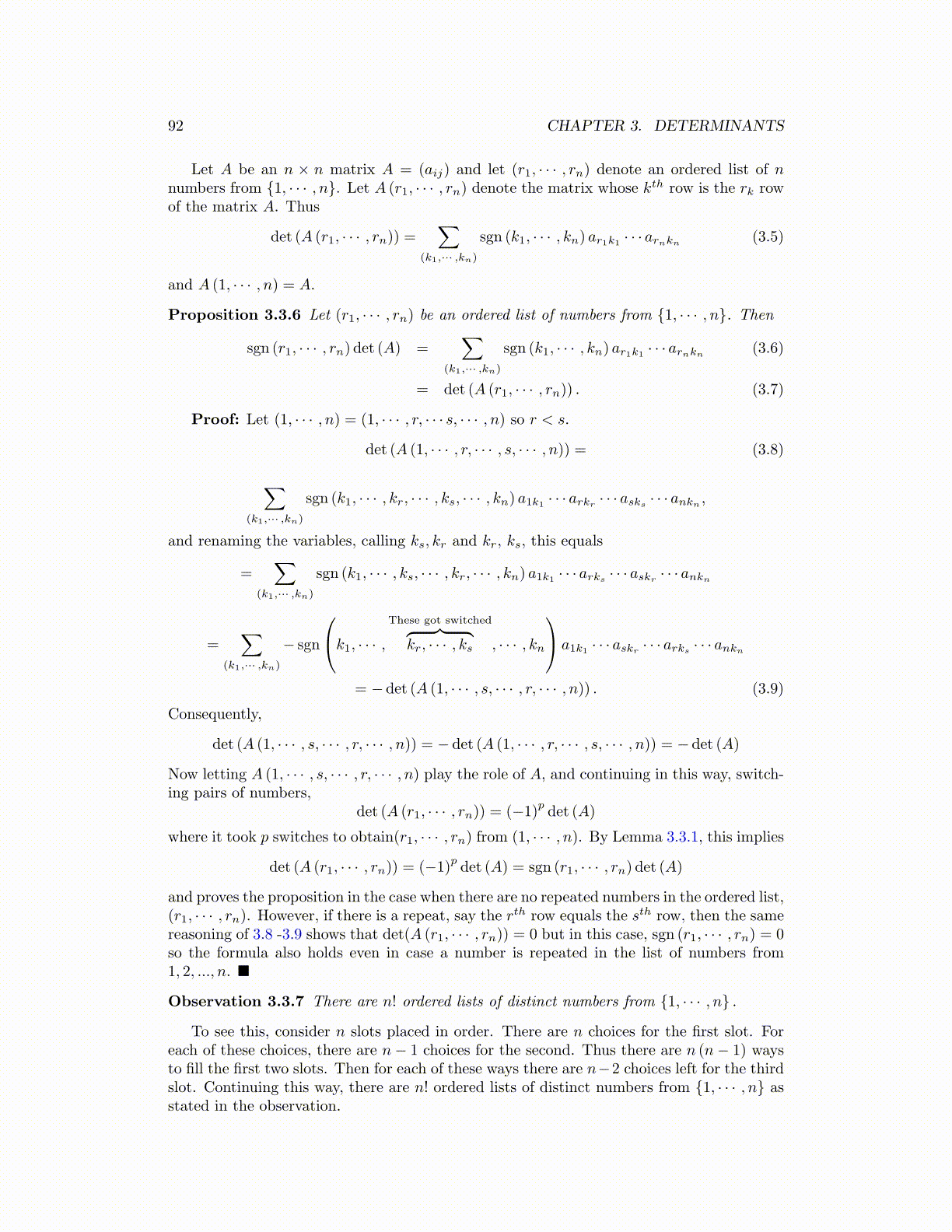
92 CHAPTER 3. DETERMINANTS
Let A be an n × n matrix A = (aij) and let (r1, · · · , rn) denote an ordered list of nnumbers from {1, · · · , n}. Let A (r1, · · · , rn) denote the matrix whose kth row is the rk rowof the matrix A. Thus
det (A (r1, · · · , rn)) =∑
(k1,··· ,kn)
sgn (k1, · · · , kn) ar1k1 · · · arnkn (3.5)
and A (1, · · · , n) = A.
Proposition 3.3.6 Let (r1, · · · , rn) be an ordered list of numbers from {1, · · · , n}. Then
sgn (r1, · · · , rn) det (A) =∑
(k1,··· ,kn)
sgn (k1, · · · , kn) ar1k1· · · arnkn
(3.6)
= det (A (r1, · · · , rn)) . (3.7)
Proof: Let (1, · · · , n) = (1, · · · , r, · · · s, · · · , n) so r < s.
det (A (1, · · · , r, · · · , s, · · · , n)) = (3.8)
∑(k1,··· ,kn)
sgn (k1, · · · , kr, · · · , ks, · · · , kn) a1k1· · · arkr
· · · asks· · · ankn
,
and renaming the variables, calling ks, kr and kr, ks, this equals
=∑
(k1,··· ,kn)
sgn (k1, · · · , ks, · · · , kr, · · · , kn) a1k1· · · arks
· · · askr· · · ankn
=∑
(k1,··· ,kn)
− sgn
k1, · · · ,These got switched︷ ︸︸ ︷kr, · · · , ks , · · · , kn
a1k1 · · · askr · · · arks · · · ankn
= −det (A (1, · · · , s, · · · , r, · · · , n)) . (3.9)
Consequently,
det (A (1, · · · , s, · · · , r, · · · , n)) = −det (A (1, · · · , r, · · · , s, · · · , n)) = −det (A)
Now letting A (1, · · · , s, · · · , r, · · · , n) play the role of A, and continuing in this way, switch-ing pairs of numbers,
det (A (r1, · · · , rn)) = (−1)pdet (A)
where it took p switches to obtain(r1, · · · , rn) from (1, · · · , n). By Lemma 3.3.1, this implies
det (A (r1, · · · , rn)) = (−1)pdet (A) = sgn (r1, · · · , rn) det (A)
and proves the proposition in the case when there are no repeated numbers in the ordered list,(r1, · · · , rn). However, if there is a repeat, say the rth row equals the sth row, then the samereasoning of 3.8 -3.9 shows that det(A (r1, · · · , rn)) = 0 but in this case, sgn (r1, · · · , rn) = 0so the formula also holds even in case a number is repeated in the list of numbers from1, 2, ..., n. ■
Observation 3.3.7 There are n! ordered lists of distinct numbers from {1, · · · , n} .
To see this, consider n slots placed in order. There are n choices for the first slot. Foreach of these choices, there are n− 1 choices for the second. Thus there are n (n− 1) waysto fill the first two slots. Then for each of these ways there are n−2 choices left for the thirdslot. Continuing this way, there are n! ordered lists of distinct numbers from {1, · · · , n} asstated in the observation.